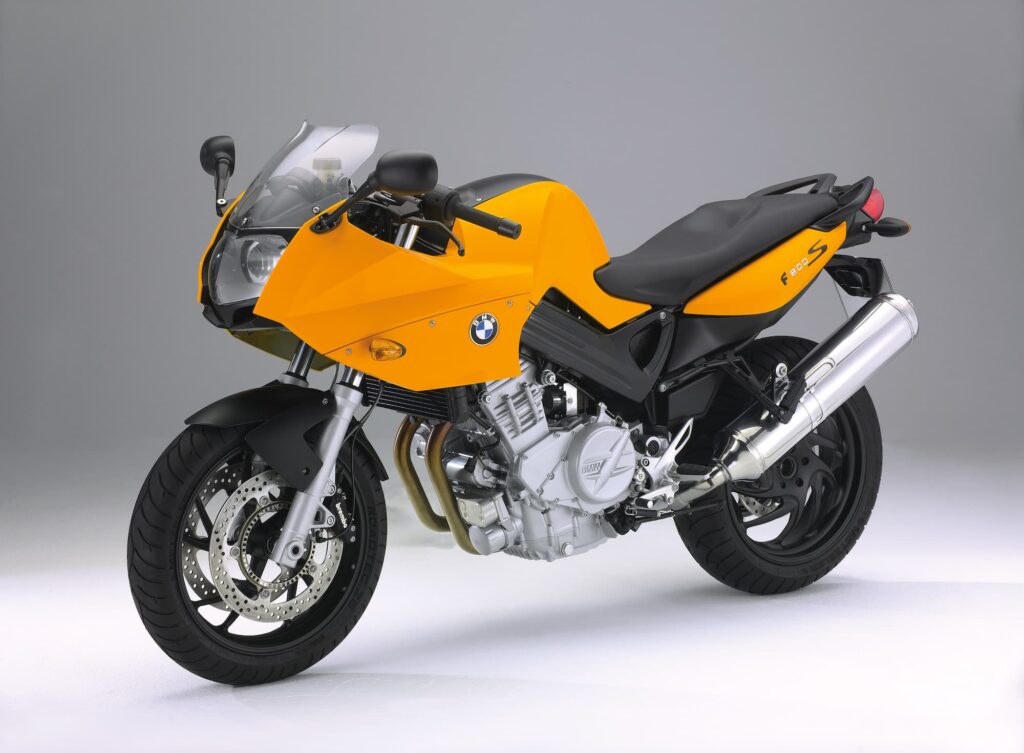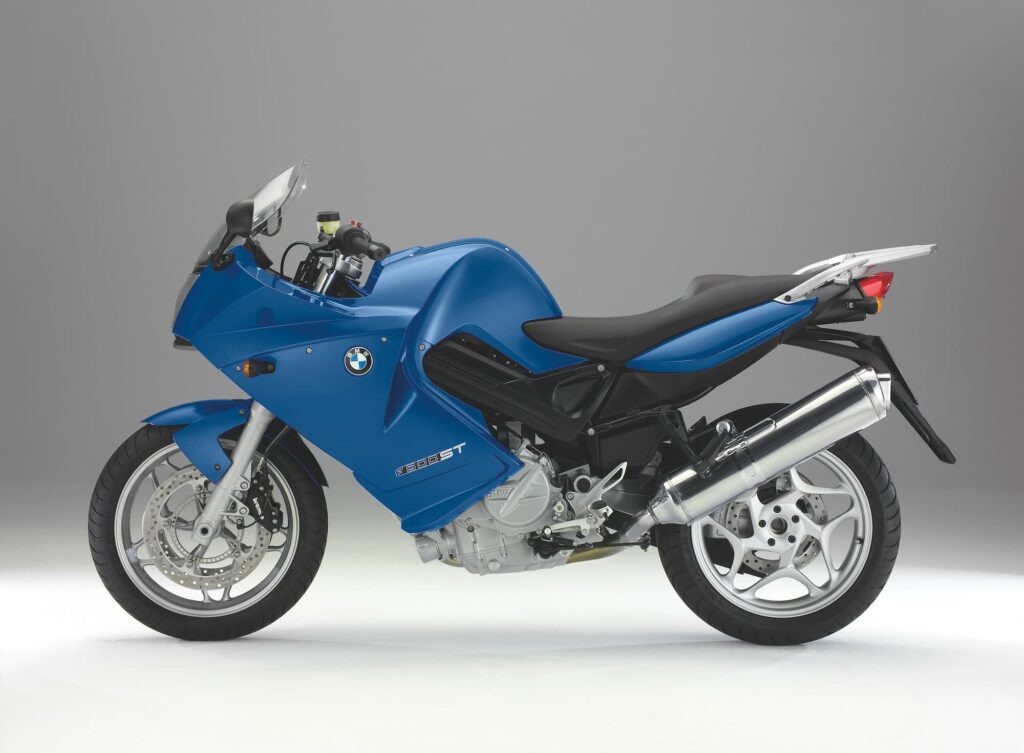BMW F 800 S / ST (2006-2012) Simplified Maintenance Schedule
This is the simplified maintenance schedule for the BMW F 800 S and ST sport / sport touring middleweight motorcycles made between 2006 and 2012, though the S was discontinued earlier.
The BMW F 800 S and F 800 ST are similar apart from external cosmetic differences. They share an underlying framework and even user manuals.
The core of the BMW F 800 S and ST is a 798 cc liquid-cooled parallel twin engine with four valves per cylinder and dual overhead camshafts. It makes peak power of 62.5 kW / 85 hp at 8000 rpm, and peak torque of 86 Nm / 63 lb-ft at 5800 rpm. It’s a similar platform to that of the F 800 GS of the day.
Unconventionally for middleweight bikes, the BMW F 800 S and ST both have a toothed belt final drive for low maintenance on long trips.
There’s a lot that makes the BMW F 800 S and F 800 ST interesting — see the “about” section below.
BMW discontinued the F 800 S model gradually between 2007 and 2010 in various markets. BMW eventually superseded the BMW F 800 ST with the BMW F 800 GT, a more touring-oriented motorcycle.
This post was originally published Sep 30, 2022, but has since been significantly revised.
This site has links from which we earn a commission (which unfortunately nobody can save, not even us). If you appreciate this research work, then please use those links. Thanks.
BMW F 800 S / ST Service Intervals
The BMW F 800 S / ST has 10000 km / 6000 mile service intervals at which point you should change the oil and filter and do a series of checks. BMW also mandates an annual oil change, regardless of how far you travelled.
Check the valve clearances every two services (every 20000 km / 12000 miles).
Like many BMW motorcycles, BMW also specifies an annual service for the F 800 S / ST in which you have to do a bunch of checks for leaks, lubrication, and general condition.
As the BMW F 800 ST and F 800 S has a belt final drive, make sure you check its condition and ensure that it’s under the correct tension.
BMW F 800 S / ST Maintenance Schedule
Below is the full maintenance schedule of the BMW F 800 S / ST.
It’s adapted from the manual (see screenshots below). But we simplified it by breaking it into two parts and shortening the schedule, as it’s repetitive.
F 800 S / ST Standard Annual Service
Below is the standard annual service for the BMW F 800 ST and F 800 S. Do this according to the schedule below. It’s a list of things to check.
Items marked [D] need specialist dealer tools.
| F 800 S / ST Standard Annual Service |
|---|
| [D] Performing vehicle test with BMW Motorrad diagnostic system |
| Check coolant level * Note: Also recommended to check coolant corrosion inhibitors with a test strip from any auto parts store. Change if necessary. |
| Check/adjust clutch play |
| Check freedom of movement of throttle cable and Check for kinks and chafing |
| Check front and rear brake discs for wear |
| Check front and rear brake pads for wear |
| Check front and rear brake fluid level |
| Check rear wheel drive bearing |
| Visually inspect the brake pipes, brake hoses and connections |
| Check toothed belt for cracks / damage |
| Check belt tension, adjust if necessary |
| Check steering-head bearing |
| Check ease of movement / lubrication of side stand |
| Check tire pressures and tread depth |
| Check torque of threaded fasteners with torque wrench: * Main frame bolts * Front footrest plate fasteners * Exhaust manifold * Eccentric clamp |
| Check lights and signalling equipment |
| Check engine start suppression (clutch, kickstand, gear, kill switch) |
| Final inspection and check of roadworthiness |
| Check battery charge state |
| [D] Confirm BMW Service in on-board documentation |
F800 S / ST Maintenance Schedule
Below is the full maintenance schedule for the F 800 S / ST, including oil changes and valve clearance checks.
Notes
- Keep following this schedule in the pattern shown, repeating every 6000 miles / 10000 km or every year.
- Follow the earlier of the distance-based or time-based interval. For example, change engine oil every year or 6000 miles / 10000 km, as necessary.
| mi x 1000 | 6 | 12 | 18 | 24 | |
|---|---|---|---|---|---|
| km x 1000 | 10 | 20 | 30 | 40 | Every |
| Perform full standard annual service (see above) | Year | ||||
| Change engine oil | ✓ | ✓ | ✓ | ✓ | Year |
| Change oil filter | ✓ | ✓ | ✓ | ✓ | Year |
| Change brake fluid in entire system | 2 years | ||||
| Check / adjust valve clearances | ✓ | ✓ | |||
| Replace spark plugs | ✓ | ✓ | |||
| Replace air filter | ✓ | ✓ | |||
| Replace toothed belt and judder damper | ✓ | ||||
| Change coolant (BMW Coolant) | 4 years |
Note that the manual doesn’t specify changing the coolant, but the service manual does.
About the BMW F 800 S and F 800 ST

The BMW F 800 ST and F 800 S are quite unique motorcycles with very few direct parallels because of their features.
Yes, at their core, they’re both middleweight comfortable sporty motorcycles. They have that unique BMW characteristic of being “zippy” without being frenetic, comfortable, and very reliable.
The BMW F 800 S and BMW F 800 ST are quite similar in technical spec. They’re both based on the same 798 cc parallel twin engine tuned for both midrange torque and a bit of top-end push. The engine has the same tune in both motorcycles.
Both bikes also have a belt final drive.
Here are a few things that are unique about the BMW F 800 S and ST.
- Belt final drive. Most middleweight bikes have chain final drives. In the past a few had shafts, bikes like the Yamaha Diversion 900. But belts are very rare other than on big-bore cruisers.
- Single sided swing-arm. That attractive exposed rear wheel is somewhat rare on middleweight bikes, other than a few like the contemporary Ducati Monster S2R1000.
- 360-degree crankshaft. BMW implemented this for a sound and feel similar to the boxer engine. They also did it to ensure balance and smoothness, while optimising for “high torque” (but you can say that about any engine configuration).
The F 800 GS was actually the first BMW to be powered by the Rotax-developed parallel twin that was used in a number of subsequent bikes, including the F 800 GS and even the F 650 GS (same engine, but lower power).
BMW also uses a system of a balance conrod and balance arm moving in the opposite direction to the engine’s conrods to almost totally eliminate first and second-order mass for a very vibe-free ride.
Here’s how the F 800 S and F 800 ST differ. It’s mostly in external aspects.
| Part | F 800 S | F 800 ST |
|---|---|---|
| Windscreen | Low | High |
| Fairing | Short / semi | Full |
| Handlebar | Low, short | High tubular |
| Rear features | Grab handles | Luggage rack |
| Wheel design (“BMW name”) | Turbine design (“Speed wheels”) | Five dual spoke (“Dynamic wheels”) |
| Front wheel cover | Black | Painted |
Since the BMW F 800 S and F 800 ST are mostly the same, their maintenance schedules are also the same.
The BMW F 800 ST outsold the F 800 S in every market, simply because the bikes were so similar but the F 800 ST offered so much more. As both bikes were intended to be “all rounders”, the fact that the ST comes with more protection and farkles just makes even MORE of an all-rounder. More “all”.
Riding the BMW F 800 ST is great, which is kind of shocking considering that this is BMW’s first parallel twin bike. The engine is perfect for what it does — lots of midrange, and enough top-end sparkle to keep things interesting.
Reference — Manual for the BMW F 800 ST
The above information comes from a variety of sources, including the manual for the BMW F 800 ST, service instructions from the service CD-ROM, and parts catalogues online.
You can download BMW manuals from BMW directly.

















